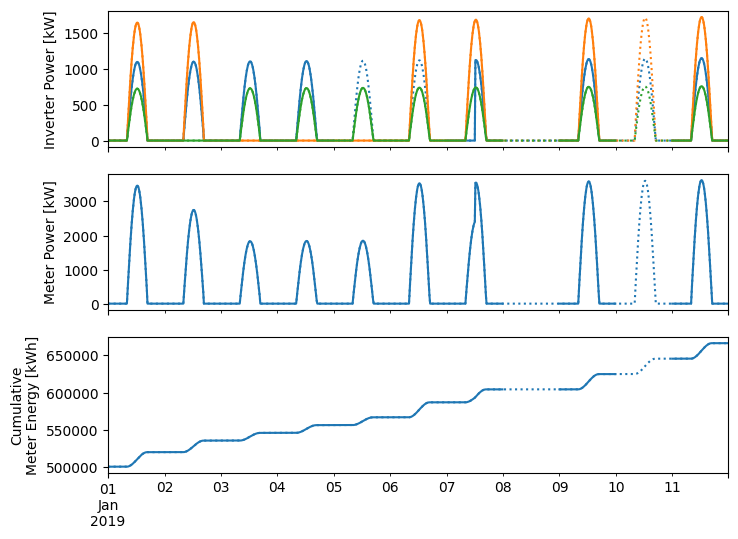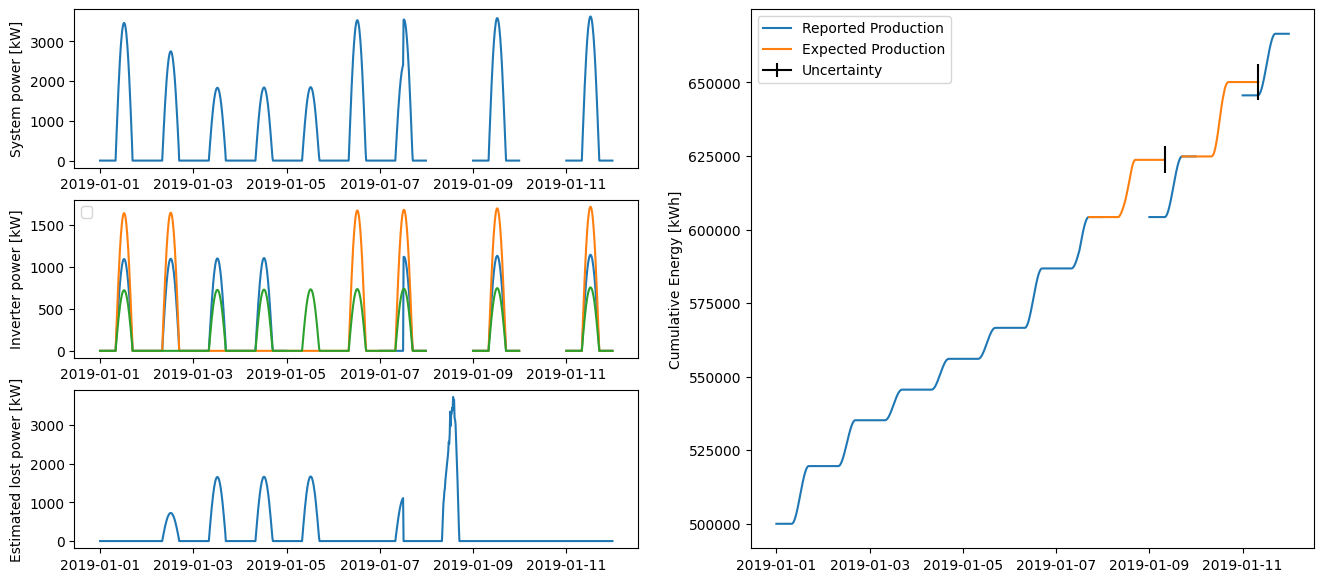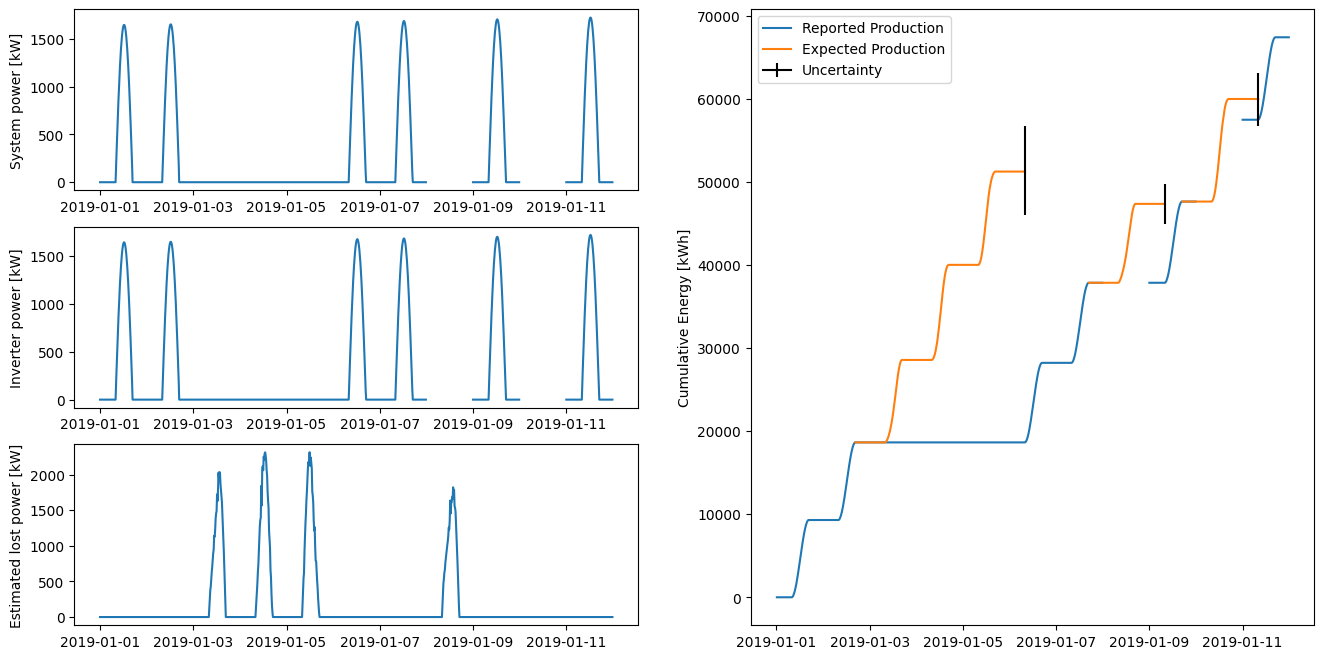System availability example¶
This notebook shows example usage of the inverter availability functions. As with the degradation and soiling example, we recommend installing the specific versions of packages used to develop this notebook. This can be achieved in your environment by running pip install -r requirements.txt followed by pip install -r docs/notebook_requirements.txt from the base directory. (RdTools must also be separately installed.) These environments and examples are tested with Python 3.10.
RdTools currently implements two methods of quantifying system availability. The first method compares power measurements from inverters and the system meter to distinguish subsystem communication interruptions from true outage events. The second method determines the uncertainty bounds around an energy estimate of a total system outage and compares with true production calculated from a meter’s cumulative production measurements. The RdTools AvailabilityAnalysis class uses both methods to
quantify downtime loss.
These methods are described in K. Anderson and R. Blumenthal, “Overcoming Communications Outages in Inverter Downtime Analysis”, 2020 IEEE 47th Photovoltaic Specialists Conference (PVSC).
[1]:
import rdtools
import pvlib
import pandas as pd
import numpy as np
import matplotlib.pyplot as plt
Quantifying the production impact of inverter downtime events is complicated by gaps in a system’s historical data caused by communication interruptions. Although communication interruptions may prevent remote operation, they usually do not result in production loss. Accurate production loss estimates require the ability to distinguish true outages from communication interruptions.
The first method focuses on partial outages where some of a system’s inverters are reporting production and some are not. In these cases, the method examines the AC power measurements at the inverter and system meter level to classify each timestamp individually and estimate timeseries production loss. This level of granularity is made possible by comparing timeseries power measurements between inverters and the meter.
Create a test dataset¶
First we’ll generate a test dataset to demonstrate the method. This code block just puts together an artificial dataset to use for the analysis – feel free to skip ahead to where it gets plotted.
[2]:
def make_dataset():
"""
Make an example dataset with several types of data outages for availability analysis.
Returns
-------
df_reported : pd.DataFrame
Simulated data as a data acquisition system would report it, including the
effect of communication interruptions.
df_secret : pd.DataFrame
The secret true data of the system, not affected by communication
interruptions. Only used for comparison with the analysis output.
expected_power : pd.Series
An "expected" power signal for this hypothetical PV system, simulating a
modeled power from satellite weather data or some other method.
(This function creates instantaneous data. SystemAvailability is technically designed
to work with right-labeled averages. However, for the purposes of the example, the
approximation is suitable.)
"""
# generate a plausible clear-sky power signal
times = pd.date_range('2019-01-01', '2019-01-12', freq='15min', tz='US/Eastern',
closed='left')
location = pvlib.location.Location(40, -80)
clearsky = location.get_clearsky(times, model='haurwitz')
# just scale GHI to power for simplicity
base_power = 2.5*clearsky['ghi']
# but require a minimum irradiance to turn on, simulating start-up voltage
base_power[clearsky['ghi'] < 20] = 0
df_secret = pd.DataFrame({
'inv1_power': base_power,
'inv2_power': base_power * 1.5,
'inv3_power': base_power * 0.66,
})
# set the expected_power to be pretty close to actual power,
# but with some autocorrelated noise and a bias:
expected_power = df_secret.sum(axis=1)
np.random.seed(2020)
N = len(times)
expected_power *= 0.9 - (0.3 * np.sin(np.arange(0, N)/7 +
np.random.normal(0, 0.2, size=N)))
# Add a few days of individual inverter outages:
df_secret.loc['2019-01-03':'2019-01-05', 'inv2_power'] = 0
df_secret.loc['2019-01-02', 'inv3_power'] = 0
df_secret.loc['2019-01-07 00:00':'2019-01-07 12:00', 'inv1_power'] = 0
# and a full system outage:
full_outage_date = '2019-01-08'
df_secret.loc[full_outage_date, :] = 0
# calculate the system meter power and cumulative production,
# including the effect of the outages:
df_secret['meter_power'] = df_secret.sum(axis=1)
interval_energy = rdtools.energy_from_power(df_secret['meter_power'])
df_secret['meter_energy'] = interval_energy.cumsum()
# fill the first NaN from the cumsum with 0
df_secret['meter_energy'] = df_secret['meter_energy'].fillna(0)
# add an offset to reflect previous production:
df_secret['meter_energy'] += 5e5
# calculate cumulative energy for an inverter as well:
inv2_energy = rdtools.energy_from_power(df_secret['inv2_power'])
df_secret['inv2_energy'] = inv2_energy.cumsum().fillna(0)
# now that the "true" data is in place, let's add some communications interruptions:
df_reported = df_secret.copy()
# in full outages, we lose all the data:
df_reported.loc[full_outage_date, :] = np.nan
# add a communications interruption that overlaps with an inverter outage:
df_reported.loc['2019-01-05':'2019-01-06', 'inv1_power'] = np.nan
# and a communication outage that affects everything:
df_reported.loc['2019-01-10', :] = np.nan
return df_reported, df_secret, expected_power
Let’s visualize the dataset before analyzing it with RdTools. The dotted lines show the “true” data that wasn’t recorded by the datalogger because of interrupted communications.
[3]:
df, df_secret, expected_power = make_dataset()
fig, axes = plt.subplots(3, 1, sharex=True, figsize=(8,6))
colors = plt.rcParams['axes.prop_cycle'].by_key()['color'][:3]
# inverter power
df_secret[['inv1_power', 'inv2_power', 'inv3_power']].plot(ax=axes[0],
legend=False, ls=':',
color=colors)
df[['inv1_power', 'inv2_power', 'inv3_power']].plot(ax=axes[0], legend=False)
# meter power
df_secret['meter_power'].plot(ax=axes[1], ls=':', color=colors[0])
df['meter_power'].plot(ax=axes[1])
# meter cumulative energy
df_secret['meter_energy'].plot(ax=axes[2], ls=':', color=colors[0])
df['meter_energy'].plot(ax=axes[2])
axes[0].set_ylabel('Inverter Power [kW]')
axes[1].set_ylabel('Meter Power [kW]')
axes[2].set_ylabel('Cumulative\nMeter Energy [kWh]')
plt.show()

Note that the solid lines show the data that would be available in our example while the dotted lines show the true underlying behavior that we normally wouldn’t know.
If we hadn’t created this dataset ourselves, it wouldn’t necessarily be obvious why the meter shows low or no production on some days – maybe it was just cloudy weather, maybe it was a nuisance communication outage (broken cell modem power supply, for example), or maybe it was a true power outage. This example also shows how an inverter can appear to be offline while actually producing normally. For example, just looking at inverter power on the 5th, it appears that only the small inverter is producing. However, the meter shows two inverters’ worth of production. Similarly, the 6th shows full meter production despite one inverter not reporting power. Using only the inverter-reported power would overestimate the production loss because of the communication interruption.
System availability analysis¶
Now we’ll hand this data off to RdTools for analysis:
[4]:
from rdtools.availability import AvailabilityAnalysis
aa = AvailabilityAnalysis(
power_system=df['meter_power'],
power_subsystem=df[['inv1_power', 'inv2_power', 'inv3_power']],
energy_cumulative=df['meter_energy'],
power_expected=expected_power,
)
# identify and classify outages, rolling up to daily metrics for this short dataset:
aa.run(rollup_period='D')
/Users/mdecegli/opt/anaconda3/envs/tempY/lib/python3.10/site-packages/rdtools/availability.py:17: UserWarning: The availability module is currently experimental. The API, results, and default behaviors may change in future releases (including MINOR and PATCH releases) as the code matures.
warnings.warn(
First, we can visualize the estimated power loss and outage information:
[12]:
fig = aa.plot()
fig.set_size_inches(16, 7)
fig.axes[1].legend(loc='upper left')
fig
/Users/mdecegli/opt/anaconda3/envs/tempY/lib/python3.10/site-packages/rdtools/plotting.py:385: UserWarning: The availability module is currently experimental. The API, results, and default behaviors may change in future releases (including MINOR and PATCH releases) as the code matures.
warnings.warn(
No artists with labels found to put in legend. Note that artists whose label start with an underscore are ignored when legend() is called with no argument.
[12]:

Examining the plot of estimated lost power, we can see that the estimated loss is roughly in proportion to the amount of offline capacity. In particular, the loss estimate is robust to mixed outage and communication interruption like on the 5th when only the smallest inverter is reporting production but the analysis correctly inferred that one of the other inverters is producing but not communicating.
RdTools also reports rolled-up production and availability metrics:
[6]:
pd.set_option('precision', 3)
aa.results
[6]:
| lost_production | actual_production | availability | |
|---|---|---|---|
| 2019-01-01 00:00:00-05:00 | 0.000 | 19606.785 | 1.000 |
| 2019-01-02 00:00:00-05:00 | 4114.031 | 15583.450 | 0.791 |
| 2019-01-03 00:00:00-05:00 | 9396.788 | 10399.112 | 0.525 |
| 2019-01-04 00:00:00-05:00 | 9466.477 | 10476.235 | 0.525 |
| 2019-01-05 00:00:00-05:00 | 9522.325 | 10538.040 | 0.525 |
| 2019-01-06 00:00:00-05:00 | 0.000 | 20185.784 | 1.000 |
| 2019-01-07 00:00:00-05:00 | 2859.565 | 17459.339 | 0.859 |
| 2019-01-08 00:00:00-05:00 | 19448.084 | 0.000 | 0.000 |
| 2019-01-09 00:00:00-05:00 | 0.000 | 20607.950 | 1.000 |
| 2019-01-10 00:00:00-05:00 | 0.000 | 20763.718 | 1.000 |
| 2019-01-11 00:00:00-05:00 | 0.000 | 20926.869 | 1.000 |
The AvailabilityAnalysis object has other attributes that may be useful to inspect as well. The outage_info dataframe has one row for each full system outage with several columns, perhaps the most interesting of which are type and loss.
See AvailabilityAnalysis? or help(AvailabilityAnalysis) for full descriptions of the available attributes.
[7]:
pd.set_option('precision', 2)
# Show the first half of the dataframe
N = len(aa.outage_info.columns)
aa.outage_info.iloc[:, :N//2]
[7]:
| start | end | duration | intervals | daylight_intervals | error_lower | error_upper | |
|---|---|---|---|---|---|---|---|
| 0 | 2019-01-07 17:00:00-05:00 | 2019-01-09 08:00:00-05:00 | 1 days 15:00:00 | 157 | 35 | -0.24 | 0.25 |
| 1 | 2019-01-09 17:00:00-05:00 | 2019-01-11 08:00:00-05:00 | 1 days 15:00:00 | 157 | 35 | -0.24 | 0.25 |
[8]:
# Show the second half
aa.outage_info.iloc[:, N//2:]
[8]:
| energy_expected | energy_start | energy_end | energy_actual | ci_lower | ci_upper | type | loss | |
|---|---|---|---|---|---|---|---|---|
| 0 | 19448.08 | 604248.74 | 604248.74 | 0.00 | 14819.33 | 24271.15 | real | 19448.08 |
| 1 | 25284.75 | 624856.69 | 645620.41 | 20763.72 | 19266.84 | 31555.29 | comms | 0.00 |
Other use cases¶
Although this demo applies the methods for an entire PV system (comparing inverters against the meter and comparing the meter against expected power), it can also be used at the individual inverter level. Because there are no subsystems to compare against, the “full outage” analysis branch is used for every outage. That means that instead of basing the loss off of the other inverters, it relies on the expected power time series being accurate, which in this example causes the loss estimates to lose some accuracy. In this case, because the expected power signal is somewhat inaccurate, it causes the loss estimate to be overestimated:
[9]:
# make a new analysis object:
aa2 = rdtools.availability.AvailabilityAnalysis(
power_system=df['inv2_power'],
power_subsystem=df['inv2_power'].to_frame(),
energy_cumulative=df['inv2_energy'],
# okay to use the system-level expected power here because it gets rescaled anyway
power_expected=expected_power,
)
# identify and classify outages, rolling up to daily metrics for this short dataset:
aa2.run(rollup_period='D')
print(aa2.results['lost_production'])
2019-01-01 00:00:00-05:00 0.00
2019-01-02 00:00:00-05:00 0.00
2019-01-03 00:00:00-05:00 9931.24
2019-01-04 00:00:00-05:00 11453.27
2019-01-05 00:00:00-05:00 11238.57
2019-01-06 00:00:00-05:00 0.00
2019-01-07 00:00:00-05:00 0.00
2019-01-08 00:00:00-05:00 9505.33
2019-01-09 00:00:00-05:00 0.00
2019-01-10 00:00:00-05:00 0.00
2019-01-11 00:00:00-05:00 0.00
Freq: D, Name: lost_production, dtype: float64
[10]:
aa2.plot()
/Users/mdecegli/opt/anaconda3/envs/tempY/lib/python3.10/site-packages/rdtools/plotting.py:385: UserWarning: The availability module is currently experimental. The API, results, and default behaviors may change in future releases (including MINOR and PATCH releases) as the code matures.
warnings.warn(
[10]:
